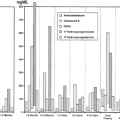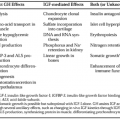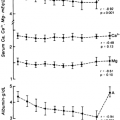STRATEGIES FOR MAPPING GENES ON CHROMOSOMES
GENETIC LINKAGE MAPS AND QUANTITATIVE TRAIT LOCI
A genetic linkage map shows the relative locations of specific DNA markers along the chromosome.22,23,24,25,26 and 27 Any inherited physical or molecular characteristic that differs among individuals and is easily detectable in the laboratory is a potential genetic marker. Markers can be expressed DNA regions or DNA segments that have no known coding function, but whose inheritance pattern can be followed. DNA sequence differences (polymorphisms; i.e., nucleotide differences) are especially useful markers because they are plentiful and easy to characterize precisely. Markers must be polymorphic to be useful in mapping. Alternative DNA polymorphisms exist among individuals, even among members of a single family, so that they are detectable among different families. Polymorphisms are variations in DNA sequence in the genome that occur every 300 to 500 base pairs. Variations within protein-encoding exon sequences can lead to observable phenotypic changes (e.g., differences in eye color, blood type, and disease susceptibility). Most variations occur within introns and have little or no effect on the phenotype (unless they alter exonic splicing patterns), yet these polymorphisms in DNA sequence are detectable and can be used as markers. Examples of these types of markers are: (a) restriction fragment length polymorphisms (RFLPs), which reflect sequence variations in DNA sites that are cleaved by specific DNA restriction enzymes; and (b) variable number of tandem repeat sequences (VNTRs), which are short repeated sequences that vary in the number of repeated units and, therefore, in length. The human genetic linkage map is constructed by observing how frequently any two polymorphic markers are inherited together.
Two genetic markers that are in close proximity tend to be passed together from mother to child. During gametogenesis, homologous recombination events take place in the metaphase of the first meiotic step (meiotic recombination crossing-over). This may result in the separation of two markers that originally resided on the same chromosome. The closer the markers are to each other, the more tightly linked they are and the less likely that a recombination event will fall between and separate them. Recombination frequency provides an estimate of the distance between two markers.
On the genetic map, distances between markers are measured in terms of centimorgans (cM), named after the American geneticist Thomas Hunt Morgan. Two markers are said to be 1 cM apart if they are separated by recombination 1% of the time. A genetic distance of 1 cM is roughly equal to a physical distance of 1 million base pairs of DNA (1 Mb). The current resolution of most human genetic map regions is approximately 10 Mb.
An inherited disease can be located on the map by following the inheritance of a DNA marker present in affected individuals but absent in unaffected individuals, although the molecular basis of a disease or a trait may be unknown. Linkage studies have been used to identify the exact chromosomal location of several important genes associated with diseases, including cystic fibrosis, sickle cell disease, Tay-Sachs disease, fragile X syndrome, and myotonic dystrophy.
RESTRICTION ENZYMES AND CHROMOSOMAL MAPPING
The restriction endonucleases, which have been isolated from various bacteria, recognize short DNA sequences and cut DNA molecules at those specific sites. A natural biofunction of restriction endonucleases is to protect bacteria from viral infection or foreign DNA by destroying the alien DNA. Some restriction enzymes cut DNA very infrequently, generating a
small number of very large fragments, whereas other restriction enzymes cut DNA more frequently, yielding many smaller fragments. Because hundreds of different restriction enzymes have been characterized, DNA can be cut into many differentsized fragments.
small number of very large fragments, whereas other restriction enzymes cut DNA more frequently, yielding many smaller fragments. Because hundreds of different restriction enzymes have been characterized, DNA can be cut into many differentsized fragments.
Stay updated, free articles. Join our Telegram channel

Full access? Get Clinical Tree






